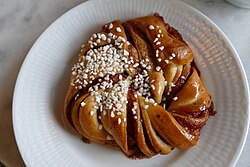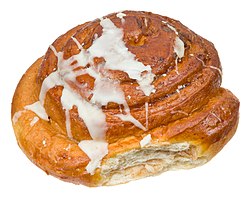Cinnamon roll
 A Swedish cinnamon bun or kanelbulle with pearl sugar | |
| Alternative names | Cinnamon bun, cinnamon swirl, cinnamon Danish, cinnamon snail |
|---|---|
| Type | sweet roll |
| Main ingredients | flour, cinnamon, sugar, and butter (or any other solid fat) |
A cinnamon roll (also known as cinnamon bun, cinnamon swirl, cinnamon scroll, cinnamon Danish and cinnamon snail) is a sweet roll commonly served in Northern Europe (mainly in Nordic countries, but also in Austria, Estonia, The Netherlands and Germany) and North America. There are alternative recipes that use Puff pastry instead of yeasted dough, but are constructed using a similar method.[1][2][3]
Description
[edit]
A cinnamon roll consists of a rolled sheet of yeast-leavened sweet bread dough or Viennoiserie,[4] onto which a cinnamon and sugar mixture (with some variations including brown sugar, raisins or other ingredients[5]) is sprinkled over a thin coat of butter.[6] The dough is then rolled, cut into individual portions and normally baked, however a deep fried version is called cinnamon roll or cinnamon bun doughnut.[7]


Origins
[edit]Arab spice traders introduced the Sri Lankan cinnamon spice to Europe.[8][9] The origin of cinnamon rolls is unknown, but might be in Byzantium.[10]
The oldest recorded recipes for cinnamon rolls are from Germany in the 16th century.[10] Cinnamon rolls spread from Germany to Scandinavia,[10] with the modern Swedish kanelbulle (lit. ''cinnamon bun'') being created after the first world war. They spread to the United States with German immigrants.[10]
Size
[edit]The size of a cinnamon roll varies from place to place, but many vendors supply a smaller size about 5 centimeters (2.0 in) in diameter and a larger size about 10 cm (3.9 in) to a side. The larger variety can be found in Finland, called korvapuusti (lit. 'a 'cuff on the ear'', fig. "pulling someone's ear for disciplining"), where it can be up to 20 cm (7.9 in) in diameter and weigh up to 200 g (7.1 oz).[11]
Haga, a district in Gothenburg, Sweden, has very large cinnamon rolls. These cinnamon rolls are called hagabullar or Queen of the Kitchen. Hagabullar are usually 30 centimeters (12 in) or more in diameter and are, despite their size, not considered a communal roll.[12]
National variations
[edit]Europe
[edit]In Denmark the cinnamon roll is known as kanelsnegl, in Sweden it is called kanelbulle, in Norway it is known as kanelbolle, skillingsbolle, kanelsnurr, or kanel i svingene, in Finland it is known as korvapuusti, in Iceland it is known as kanilsnúður, and in Estonia it is known as kaneelirull.[13][14][15] In Austria and Germany, it is called Zimtschnecke. In Slovakia and the Czech Republic, it is called škoricové slimáky/skořicoví šneci (meaning 'cinnamon snails').[16][17]
Since 1999,[18][19] October 4 has been promoted as Cinnamon Roll Day (Kanelbullens dag), a national theme day, acknowledged by a significant portion of the Swedish population. [20][21] Swedish kanelbulle dough typically also contains cardamom (powder or buds), giving it a distinctive flavour.[22]
The Swedish Butterkaka and Finnish bostonkakku ("Boston cake") is a cake made by baking cinnamon rolls in a round cake pan instead of baking them separately, so that they stick together to form a large, round cake.[23]
In Austria and Germany, they are widely available at supermarkets and bakeries. Along with Topfengolatsche, Buttercroissant and Faschingskrapfen they are a typical baked good to have with afternoon coffee, known as "Kaffe und Kuchen".[24]
A German variety, which is similar to the Scandinavian style, originating in Hamburg and its surroundings is the Franzbrötchen, a cinnamon-filled baked good inspired by the non-cinnamon French croissant.[25]
In the United Kingdom, cinnamon bun, cinnamon roll and cinnamon swirl names are all used, and generally available in most supermarkets and bakeries.[26][27]
Americas
[edit]American cinnamon rolls are frequently large, baked in a pan and topped with cream cheese icing (usually confectioners' sugar-based) and are sometimes fried, finished with glaze, and served as a variation of a raised donut. There are also regional combinations: in the American Midwest, especially Nebraska and Kansas, cinnamon rolls are commonly eaten with chili.[28]
In Canada, they are known as cinnamon rolls or cinnamon buns. They are usually self-glazed and not iced, nor do they usually have raisins.[29][30] They can have so much cinnamon that they are spicy and hot to the taste.
Asia
[edit]In Asian cultures, cinnamon rolls may be made using a yeast bread technique called tangzhong. The technique is closely associated with Japanese milk bread since it gives it a soft, feathery texture. By heating flour at exactly 65°C or 149°F, the starches within the flour will pre-gelatinize, causing it to thicken more than average. Tangzhong allows the starches to retain moisture for longer periods of time, resulting in a longer shelf life.[31]
Cinnamon roll traditions
[edit]In Sweden and Finland, cinnamon rolls are traditionally enjoyed during a get-together, including the consumption of coffee and or baked goods. In Sweden, the get-together is known as a fika, typically held in the afternoon, by coworkers during a break, by friends or by family. National Cinnamon Roll Day (Kanelbullens dag) is observed on October 4 in Sweden and Finland.[32]
In Denmark, cinnamon buns are especially popular on Wednesdays, where an extra large variant called the Wednesday snail is sold. This tradition was specially invented during the 1990s[33] where the national football team usually played their games on Wednesdays.[citation needed]
In North America, it is commonly eaten for breakfast or dessert. When eaten for breakfast in the U.S., it may be served with cream cheese frosting.[34]
Cinnamon buns are particularly popular during the Christmas season in both Slovakia and the Czech Republic. They form part of the traditional Christmas baking repertoire in many households, alongside other festive treats like vanilla crescents (vanilkové rožteky) and linzer cookies.[citation needed]
Gallery
[edit]- National variations
-
Finnish korvapuusti
-
Danish kanelsnegl
-
Norwegian skillingsbolle
-
American cinnamon roll
- Baking process
-
Raw cinnamon rolls
-
Ready to bake after proofing
-
Partially baked rolls in a solar cooker
-
Fully baked cinnamon rolls
See also
[edit]References
[edit]- ^ "Puff pastry cinnamon rolls". BBC Good Food. Retrieved June 25, 2025.
- ^ "Quick Puff Pastry Cinnamon Rolls". Gimme some oven. September 24, 2021.
- ^ "The Easiest Way to Make Cinnamon Rolls, According to Ina Garten". Parade. February 26, 2025.
- ^ Judith Fertig (2012). I Love Cinnamon Rolls. Andrews McMeel Publishing. p. ix. ISBN 9781449420697.
- ^ Judith Fertig (2012). I Love Cinnamon Rolls. Andrews McMeel Publishing. p. xii. ISBN 9781449420697.
- ^ Judith Fertig (2012). I Love Cinnamon Rolls. Andrews McMeel Publishing. p. xiii. ISBN 9781449420697.
- ^ "Cinnamon Roll Donuts". Moribyan. Retrieved June 26, 2025.
- ^ "Bringing cinnamon to Europe" (PDF). The Free Institute. Retrieved June 26, 2025.
- ^ "Harvesting 'true cinnamon': The story of the Ceylon spice". Aljazeera. October 18, 2021.
- ^ a b c d Reinhart, Peter (January 1, 2015). "breads, sweet". In Goldstein, Darra (ed.). The Oxford Companion to Sugar and Sweets. Oxford University Press. doi:10.1093/acref/9780199313396.001.0001. ISBN 978-0-19-931339-6.
Cinnamon buns are associated with Germany, where they were known as Schnecken, or "snails," for their coiled shape. Although recipes for these buns can be found in early German cookbooks from the 1500s, they may originally have been introduced from Byzantium. The buns soon spread to many places, including Scandinavia, where various forms of kanelbullar are typically served with coffee. In the early eighteenth century, many Germans moved to Pennsylvania, bringing with them their sweet pastries and other food traditions.
- ^ "Korvapuusti in Finland". Archived from the original on February 26, 2008.
- ^ "Kanelbullar.se". Kanelbullar.se. Retrieved July 17, 2016.
- ^ The Free Dictionary. "cinnamon snail". Retrieved April 17, 2013.
- ^ Carlson, Jen. "Why The Cinnamon Snail Vegan Food Truck Is The Best Food Truck In Town". The Gothamist. Archived from the original on April 7, 2013. Retrieved April 16, 2013.
- ^ "Kanelsnegl, The Danish answer to Cinnamon buns". caprisserie.com. May 22, 2016. Retrieved March 1, 2020.
- ^ "Škoricové slimáky". dobruchut. Retrieved June 26, 2025.
- ^ "Kanellbular - skořicové šneky". Toprecepty. March 18, 2013.
- ^ "Om oss". Hembakningsrådet (in Swedish). September 12, 2014. Archived from the original on June 28, 2019. Retrieved October 4, 2017.
- ^ "Så blev kanelbullen det mest svenska av alla bakverk – DN.SE". Dagens Nyheter (in Swedish). October 4, 2017. Retrieved October 4, 2017.
- ^ "Kanelbullens Dag 4 Oktober". Kanelbullensdag.se. Archived from the original on August 30, 2011. Retrieved June 4, 2010.
- ^ "Kanelbullar". Sweden.se. Archived from the original on November 8, 2013. Retrieved March 25, 2013.
- ^ Bronte Aurell (2018). ScandiKitchen: Fika and Hygge. Comforting Cakes and Bakes from Scandinavia with Love. Ryland Peters & Small. ISBN 9781788790048.
- ^ "Boston cake". Saunalahti.fi. Archived from the original on September 24, 2015. Retrieved November 18, 2012.
- ^ "Schneckennudeln (German Cinnamon Rolls)". Foxy Folksy. October 8, 2024.
- ^ "Franzbrötchen, the German croissant born as rebellion against French occupation". Berlino Schule. April 5, 2019.
- ^ "The best places to eat cinnamon buns in Britain". Olive. October 4, 2019.
- ^ "Top 10 Cinnamon Rolls". Trolley. Retrieved June 26, 2025.
- ^ "Chili and Cinnamon Rolls, is this a Kansas Thing?". Retrieved October 5, 2017.
- ^ Tagliafierro, Angelina. "UBC Cinnamon Bun". Retrieved January 12, 2019.
- ^ Lugonja, Valerie (December 19, 2016). "Helen McKinney's Canadian Prairie Homemade Cinnamon Buns". Retrieved January 12, 2019.
- ^ Anastopoulo, Rossi. "A Closer Look at Tangzhong". Retrieved December 2, 2024.
- ^ "Kanelbullens dag – 4 oktober | Temadagar". temadagar.se. October 3, 2009.
- ^ "triviatirsdag: onsdagssnegl". August 22, 2017.
- ^ "Screamin' Cinnamon Rolls With Cream Cheese Frosting". Food.com. Retrieved July 20, 2016.








